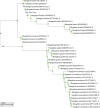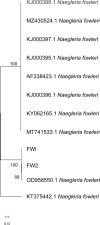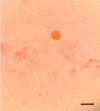Rare Naegleria fowleri meningoencephalitis diagnosed via combined molecular biology and metagenomic sequencing techniques: a case report
- PMID: 40676680
- PMCID: PMC12273379
- DOI: 10.1186/s40249-025-01347-z
Rare Naegleria fowleri meningoencephalitis diagnosed via combined molecular biology and metagenomic sequencing techniques: a case report
Abstract
Background: Naegleria fowleri, a pathogenic free-living amoeba, causes primary amoebic meningoencephalitis (PAM), a rare but devastating disease with acute onset, rapid progression, and > 95% mortality. Despite its rarity, the catastrophic outcomes associated with this infection underscore the critical importance of prevention. In this report, we present a rare pediatric fatality caused by PAM in China, highlighting the challenges of diagnosis and treatment.
Case presentation: A 6-year-old child from Lushan County, Henan Province, developed persistent high fever, headache, vomiting, and altered mental status on December 5, 2024. After receiving ineffective local treatment, the child was transferred to the Eastern District of Henan Children's Hospital on December 7 for further evaluation and management. Upon admission, cerebrospinal fluid was collected for laboratory analysis, and antimicrobial therapy, including amphotericin B, fluconazole, and rifampicin, was promptly initiated. Despite these interventions, the patient's condition deteriorated rapidly, and the child succumbed to the infection on December 9.
Conclusions: Clinical and laboratory findings strongly suggest that the child was infected with N. fowleri, resulting in PAM. Epidemiological investigation suggests possible exposure at a public bathhouse. Given the survival characteristics of the N. fowleri and potential habitat expansion due to global warming, this sporadic case underscores PAM's lethal potential. With mortality exceeding 95%, early recognition and prompt intervention are crucial. Clinicians should maintain high suspicion for PAM in patients with compatible symptoms, especially in regions with warm freshwater exposure.
Keywords: Naegleria fowleri; Genetic analysis; Metagenomic sequencing; Primary amoebic meningoencephalitis.
© 2025. The Author(s).
Conflict of interest statement
Declarations. Ethics approval and consent to participate: This study was approved by the Ethics Review Committee of the Henan Provincial Center for Disease Control and Prevention (Ethics Approval No. 2021-KY-010–02). Consent for publication: Informed consent was obtained from the families of the participants for procedures. Competing interests: The authors declare that they have no competing interests.
Figures




Similar articles
-
Challenges and Strategies in Managing Naegleria fowleri-Associated Primary Amoebic Meningoencephalitis in Pakistan: A Case Report.Acta Parasitol. 2025 Jul 7;70(4):150. doi: 10.1007/s11686-025-01091-2. Acta Parasitol. 2025. PMID: 40622499
-
Systematic Review of Brain-Eating Amoeba: A Decade Update.Int J Environ Res Public Health. 2023 Feb 9;20(4):3021. doi: 10.3390/ijerph20043021. Int J Environ Res Public Health. 2023. PMID: 36833715 Free PMC article.
-
Brain Eater Amoeba: A Case Report.J Assoc Physicians India. 2025 May;73(5):e45-e46. doi: 10.59556/japi.73.0952. J Assoc Physicians India. 2025. PMID: 40553542
-
Primary amoebic meningoencephalitis in an infant.Indian J Med Microbiol. 2019 Jan-Mar;37(1):120-122. doi: 10.4103/ijmm.IJMM_18_371. Indian J Med Microbiol. 2019. PMID: 31424023
-
A comprehensive review on the neurological impact of parasitic infections.Microb Pathog. 2025 Sep;206:107762. doi: 10.1016/j.micpath.2025.107762. Epub 2025 May 29. Microb Pathog. 2025. PMID: 40446972 Review.
References
-
- Messenger LA, Bern C. Congenital Chagas disease: current diagnostics, limitations and future perspectives. Curr Opin Infect Dis. 2018;31(5):415–21. - PubMed
-
- Chen BJ, Xie HG, Lin WH. Clinical analysis of the first Naegleria fowleri infection in Fujian Province. Chin J Zoonoses. 2022;38(01):89–92 (In Chinese).
-
- Jjahangeer M, Mahmood Z, Munir N, Waraich UE, Tahir IM, Akram M, et al. Naegleria fowleri: sources of infection, pathophysiology, diagnosis, and management; a review. Clin Exp Pharmacol Physiol. 2020;47(2):199–212. - PubMed
Publication types
MeSH terms
LinkOut - more resources
Full Text Sources
Miscellaneous

